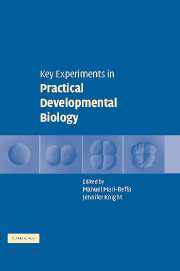Book contents
- Frontmatter
- Contents
- List of contributors
- Preface
- Introduction
- SECTION I GRAFTINGS
- SECTION II SPECIFIC CHEMICAL REAGENTS
- SECTION III BEAD IMPLANTATION
- SECTION IV NUCLEIC ACID INJECTIONS
- SECTION V GENETIC ANALYSIS
- SECTION VI CLONAL ANALYSIS
- SECTION VII IN SITU HYBRIDIZATION
- SECTION VIII TRANSGENIC ORGANISMS
- SECTION IX VERTEBRATE CLONING
- SECTION X CELL CULTURE
- SECTION XI EVO–DEVO STUDIES
- 26 Microevolution between Drosophila species
- SECTION XII COMPUTATIONAL MODELLING
- Appendix 1 Abbreviations
- Appendix 2 Suppliers
- Index
- Plate Section
- References
26 - Microevolution between Drosophila species
Published online by Cambridge University Press: 11 August 2009
- Frontmatter
- Contents
- List of contributors
- Preface
- Introduction
- SECTION I GRAFTINGS
- SECTION II SPECIFIC CHEMICAL REAGENTS
- SECTION III BEAD IMPLANTATION
- SECTION IV NUCLEIC ACID INJECTIONS
- SECTION V GENETIC ANALYSIS
- SECTION VI CLONAL ANALYSIS
- SECTION VII IN SITU HYBRIDIZATION
- SECTION VIII TRANSGENIC ORGANISMS
- SECTION IX VERTEBRATE CLONING
- SECTION X CELL CULTURE
- SECTION XI EVO–DEVO STUDIES
- 26 Microevolution between Drosophila species
- SECTION XII COMPUTATIONAL MODELLING
- Appendix 1 Abbreviations
- Appendix 2 Suppliers
- Index
- Plate Section
- References
Summary
OBJECTIVE OF THE INVESTIGATION Ever since Darwin proposed his theory of evolution by natural selection in The Origin of Species there have been questions regarding how the process of evolution occurs. Originally, such questions were studied through comparative anatomy, but more recently many of these questions have been directed at the genetic level, specifically addressing which events lead to genomic evolution. It is increasingly evident that genomes are constantly evolving systems, in which genetic changes are not always mirrored by concomitant change at the phenotypic level. One way in which this concept has been studied has been by generating hybrids between closely related species, such as those of the Drosophila genus.
The objective of this investigation is to analyse the reason(s) for loss of large mechanosensory bristles (macrochaetes) on the thorax of hybrid progeny generated by crossing Drosophila melanogaster with Drosophila simulans. To this end, three experiments will be performed, and the progeny analysed for bristle loss in each case. The first experiment will analyse the effect on bristle loss by introducing mutations from the Drosophila melanogaster parent that are known to be involved in bristle development. The second experiment will establish whether hybrid bristle loss can be rescued by over-expression of a gene responsible for bristle formation, or by introducing extra copies of this gene into hybrids. The third experiment will investigate the differences in bristle loss between male and female hybrids.
Information
- Type
- Chapter
- Information
- Key Experiments in Practical Developmental Biology , pp. 330 - 345Publisher: Cambridge University PressPrint publication year: 2005
